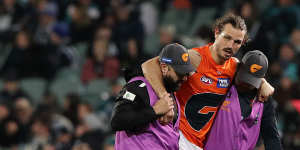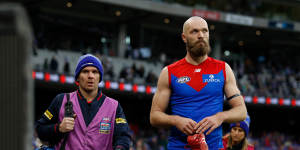There was previously a more generous annual injury allowance outside the cap that helped clubs that were hit particularly hard make extra payments,but that was capped at $400,000 last year and is down to $250,000 in 2023.

GWS Giants lost the second-most games to injury last year.AFL Photos
It is all part of the AFL’s wish to strip back discretionary spending that is not included in the salary cap,but there is so far no indication the figure will continue to drop.
Industry sources toldThe Age the average per club was $563,000 before the lower amount was introduced in response to the COVID-19 pandemic but also some teams abusing the system,including trying to have All-Australian and other related bonuses covered.

Injuries play a significant role in a team’s on and off-field fortunes.AFL Photos
,while Hawthorn (134),Essendon (114) and Carlton (109) also had a tough time with setbacks.
The reduced allowance means list managers responsible for overseeing total player payments (TPP) must be savvier than ever in forecasting how many matches their footballers may miss – an incredibly difficult task – to avoid a salary-cap squeeze.
Clubs submit to the league a projected TPP figure before each season,between December and January,that considers potential missed games through injury. Every team must spend at least 95 per cent of the salary cap,with those in rebuilding mode almost always spending less than sides expecting to contend.
Where it becomes more complex is the AFL introduced a rule several years ago whereby clubs could “bank” cap money to use in a future season – up to five per cent extra –. Clubs not maximising their cap amount will rarely need to dip into the allowance,but would lose that advantage they were planning for if they endured a horror injury run,so the rules around the allowance,also referred to as a “rebate″,are slightly different.
A rebuilding club planning to hold over money can instead bank the $250,000 rebate,even if they did not clear the salary cap. The AFL logic behind this is to not disadvantage teams in that situation.
But,usually,the allowance is not triggered until the salary cap is exhausted.

If injury payments still go beyond the rebate,the list manager must then negotiate with a player or players’ agent to defer some of their wage into the following season’s salary cap – and continue the financial headache. Typically,the contract variation will involve a footballer on significant fixed money.
This scenario is one of the reasons why back-ended contracts have become so prevalent in the AFL.
There has been a push from the league for this process to be more fixed and based on individual players’ injury history rather than a subjective submission.
But it is largely impossible for a club such as Carlton to predict a season-ending ACL injury to Zac Williams – even with his other injuries in recent years – that means a first-choice player is out for all 22 home-and-away season games,plus finals,if the Blues make it.
Star midfielder Sam Walsh will also be out for at least the first month of the season after missing only two matches combined since being the No. 1 pick in the 2018 draft.
For example,the Blues could sign Oleg Markov as an injury replacement for Williams,and he might receive $4000 per match he plays. If Markov makes 12 senior appearances,that is almost $50,000 Carlton did not account for in their pre-season estimation.
Marquee,or higher-profile,players tend to have financial guarantees built into their contract rather than being reliant on match payments. An unintended consequence of this change could be that teams will want more certainty in contracts rather than offering players as many incentives.
Making matters worse is that clubs will again enter the season in the dark on exactly how much the salary cap will increase,.
A nightmare injury run under the current circumstances could theoretically impact the ability of teams to recruit star players,with the likes of.
The AFL declined to comment on the changes to the injury allowance.